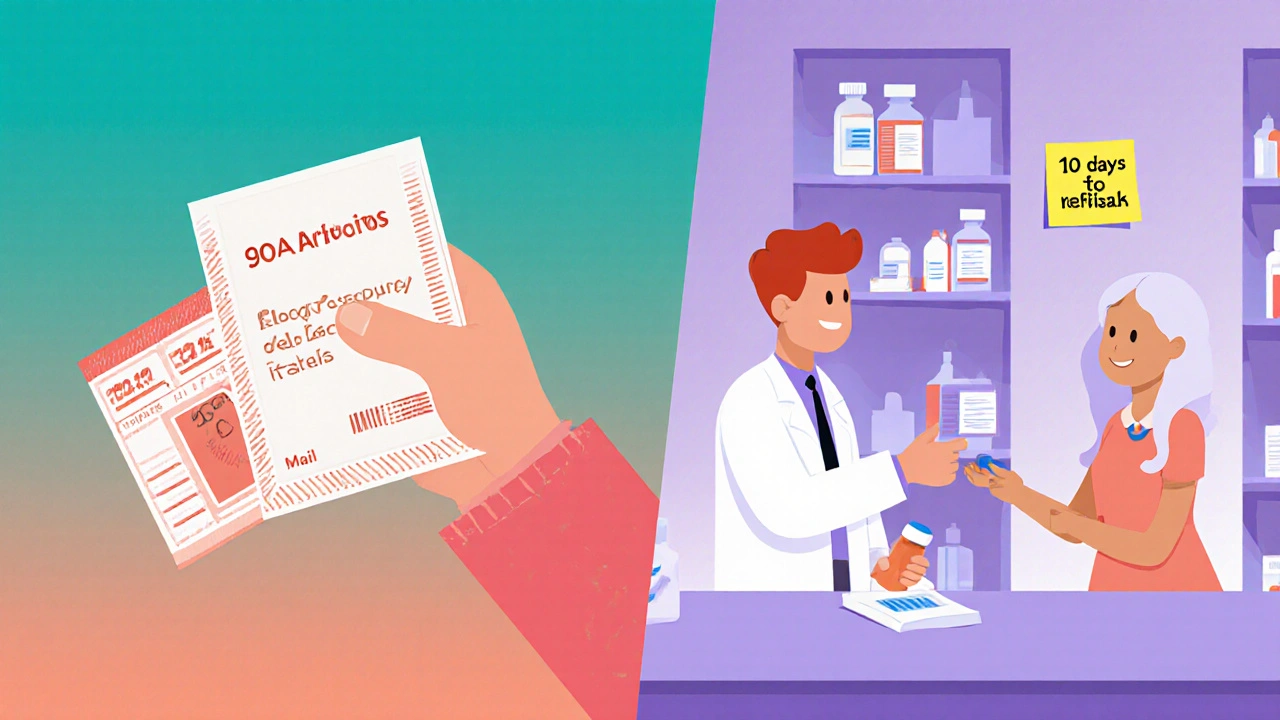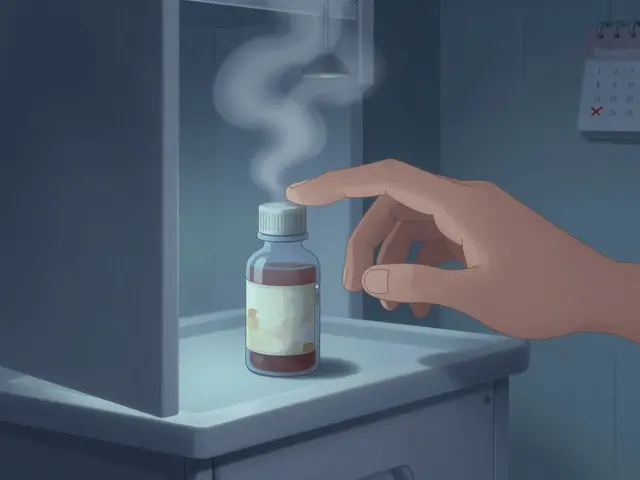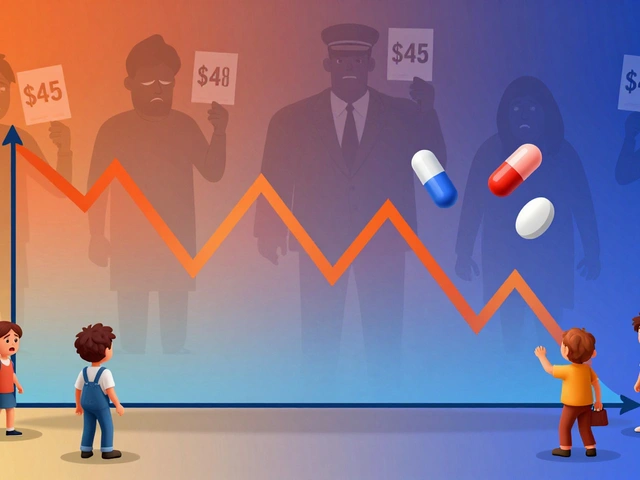Running out of your blood pressure pill on a Saturday night shouldn’t cost you $75. But if you’re only filling at your local pharmacy, that’s exactly what can happen. The truth is, you don’t have to choose between convenience and cost. You can use mail-order pharmacy for your long-term meds and your local pharmacy for the rest-and save hundreds a year doing it.
Know Which Medications Belong Where
Not all prescriptions are created equal. The key to saving money is sorting your meds into three groups: maintenance, acute, and variable-dose.- Maintenance meds are the ones you take every day, for years-like metformin for diabetes, lisinopril for high blood pressure, or levothyroxine for thyroid issues. These are perfect for mail-order.
- Acute meds are short-term: antibiotics, painkillers after surgery, or steroid packs. These need to be picked up fast. Local pharmacy only.
- Variable-dose meds are the tricky ones-meds your doctor might change often, like antidepressants or cholesterol drugs. Stick with local pharmacy until the dose stabilizes.
Check Your Insurance’s Real Costs
Your insurance plan might say mail-order saves money. But does it really? Many people assume the answer is yes-then find out their 90-day copay is $150, while the local pharmacy charges $140. That’s not a save. That’s a mistake. Here’s how to find the real numbers:- Log into your insurance portal or call member services. Ask: “What’s my copay for a 30-day supply of [medication] at a retail pharmacy?”
- Then ask: “What’s my copay for a 90-day supply through mail-order?”
- Do the same for your local pharmacy-some, like Walmart or Kroger, offer $10 generic 90-day fills even without insurance.
Mail-Order Isn’t Instant. Plan Ahead.
Mail-order pharmacies take 7 to 14 business days to deliver. That’s not a bug. It’s a feature. But if you wait until your pill bottle is empty, you’re risking a gap in treatment. Successful users set reminders. Not on your phone calendar. On a sticky note next to your medicine cabinet. Or better yet, use a refill tracker app like Medisafe or MyTherapy. Set a reminder 10-14 days before you run out. That gives you time to order, wait for shipping, and still have a buffer. One Reddit user, u/MedSaver87, saved $427 a year by doing this with his amlodipine. He didn’t have to rush to the pharmacy at 8 p.m. on a Friday because his refill was already on the way. Don’t forget: if your doctor changes your dose, mail-order systems often lag. A user on HealthUnlocked got the wrong dose of an antidepressant for two months because the pharmacy hadn’t updated their records. That cost him $65 in wasted pills. Always call your mail-order pharmacy when your prescription changes.
Local Pharmacies Are More Than Just a Pickup Spot
Most people think of local pharmacies as places to grab a script and go. But pharmacists are trained medication experts-and they’re often free to talk to. A 2011 study found 78% of patients had face-to-face consultations with local pharmacists. Mail-order? Phone support only. That matters. If you’re on five or more meds, ask your local pharmacist for a free medication review. They’ll check for interactions, suggest cheaper alternatives, and tell you if a generic version exists. One woman in Ohio saved $200 a year just by switching her statin to a generic after her pharmacist flagged it. Also, local pharmacies often run discount programs. CVS’s $4/$10/$25 generic program. Walmart’s $10 90-day generics. Kroger’s Rx savings card. These aren’t secret. They’re just ignored. Walk in and ask: “Do you have a discount program for this medication?” You’d be surprised how often the answer is yes.Don’t Assume Mail-Order Is Always Cheaper
The biggest myth? That mail-order is always the best deal. It’s not. A 2022 RAND Corporation study found that 28% of commercial insurance plans actually charge MORE for mail-order on certain specialty meds-especially those needing refrigeration or special handling. Insulin, biologics, and some cancer drugs fall into this category. Shipping them can cost more than the drug itself. Also, some plans require separate authorizations for mail-order vs. retail. That means two calls, two forms, two delays. If your plan makes it hard, just stick with local. Especially if they offer 90-day pricing. Walmart, Costco, and some independent pharmacies now offer 90-day fills at retail for the same price as mail-order. You get the savings without the wait. Ask your pharmacist: “Can you fill this as a 90-day supply under my insurance?” Most can-if you ask.Track and Adjust Every Few Months
Your plan changes. Your meds change. Your savings change. Every three to six months, do a quick audit:- Review your last three prescriptions. Are any no longer maintenance? Move them to local.
- Check if your insurance updated copays. A $12 mail-order copay might now be $18.
- Look for new discount programs. GoodRx and SingleCare often have new deals.
- Call your pharmacist. Say: “I’m trying to save on meds. Any suggestions?”

What About Medicare and Other Plans?
Medicare Part D is changing. In 2024, they’re standardizing how 90-day supplies are priced across mail-order and retail. That means the old mail-order advantage might shrink. But it doesn’t disappear. Use Medicare’s Plan Finder tool. Type in your meds. It shows you exactly what each pharmacy charges. No guessing. No calls. For Medicare Advantage plans, some cut mail-order incentives in 2023. Others doubled down. Check your plan’s annual notice. If your mail-order copay went up, ask if your local pharmacy can match it.Real People, Real Savings
Here’s what it looks like in practice:- John, 68, takes 5 daily meds. He uses mail-order for his blood pressure, cholesterol, and diabetes pills. He gets them delivered every 90 days. Saves $280/year.
- He picks up his antibiotic for a sinus infection and his painkiller after knee surgery at his local CVS. Pays $12 instead of $50.
- Sarah, 42, uses Walmart’s $10 90-day generic program for her birth control and thyroid med. She never uses mail-order. Saves $180/year.
- She gets her new migraine meds from her local pharmacy-so she can talk to the pharmacist about side effects.
Start Small. Save Big.
You don’t need to switch everything tomorrow. Pick one maintenance med-your most expensive daily pill-and try it. 1. Find out your 30-day and 90-day copays for that drug at your local pharmacy and mail-order. 2. If mail-order saves $10 or more per month, order your first 90-day supply. 3. Set a calendar reminder for 10 days before it runs out. 4. Keep your acute meds local. After three months, look at your receipts. You’ll likely see $50-$100 saved. Then do it again with the next med. This isn’t about being a pharmacy ninja. It’s about being informed. The system is designed to make you pay more by default. But you don’t have to play along. You’re not just buying pills. You’re managing a health system. And with a little strategy, you can make it work for you-not against you.Can I get 90-day supplies at my local pharmacy instead of mail-order?
Yes. Many pharmacies-including Walmart, Kroger, and CVS-offer 90-day fills at retail for the same price as mail-order. Ask your pharmacist: “Can you fill this as a 90-day supply under my insurance?” Most can, if your plan allows it. You get the savings without waiting for shipping.
What if my insurance doesn’t cover mail-order?
If your plan doesn’t offer mail-order or charges more for it, stick with local pharmacies. Use discount programs like Walmart’s $10 generics or GoodRx coupons. You can still save significantly without mail-order. Focus on generics and pharmacy loyalty programs.
How do I know if a medication is safe to send by mail?
Most pills are fine. But avoid mailing medications that need refrigeration-like insulin, some biologics, or liquid antibiotics-unless the mail-order pharmacy guarantees temperature-controlled shipping. Check with your pharmacist or the drug manufacturer. If in doubt, keep it local.
Why does my mail-order pharmacy keep sending the wrong dose?
Mail-order systems often don’t sync quickly with your doctor’s EHR. When your doctor changes your dose, call the mail-order pharmacy directly to update it. Don’t rely on automated updates. Also, ask your doctor to fax or e-prescribe the change directly to the pharmacy.
Is it worth it to coordinate pharmacies if I only take one or two meds?
Yes-if one of them is expensive. Even one maintenance med like metformin or atorvastatin can cost $10-$20 more per month at retail. That’s $120-$240 a year. If you’re paying cash or have a high deductible, those savings add up fast. Start with your most costly pill.
What if I travel a lot? Can I still use mail-order?
You can, but plan ahead. Order extra refills before trips. Or use a local pharmacy near your destination and ask them to transfer your prescription. Some mail-order companies offer temporary delivery addresses. Call them before you leave.




Joe bailey on 26 November 2025, AT 16:28 PM
Man, this is the kind of post that actually helps. I used to pay $80 for my metformin at the local pharmacy until I switched to mail-order. Now I pay $22 for 90 days. No drama, no rush. Just saved $600 last year. Why didn’t I do this sooner?